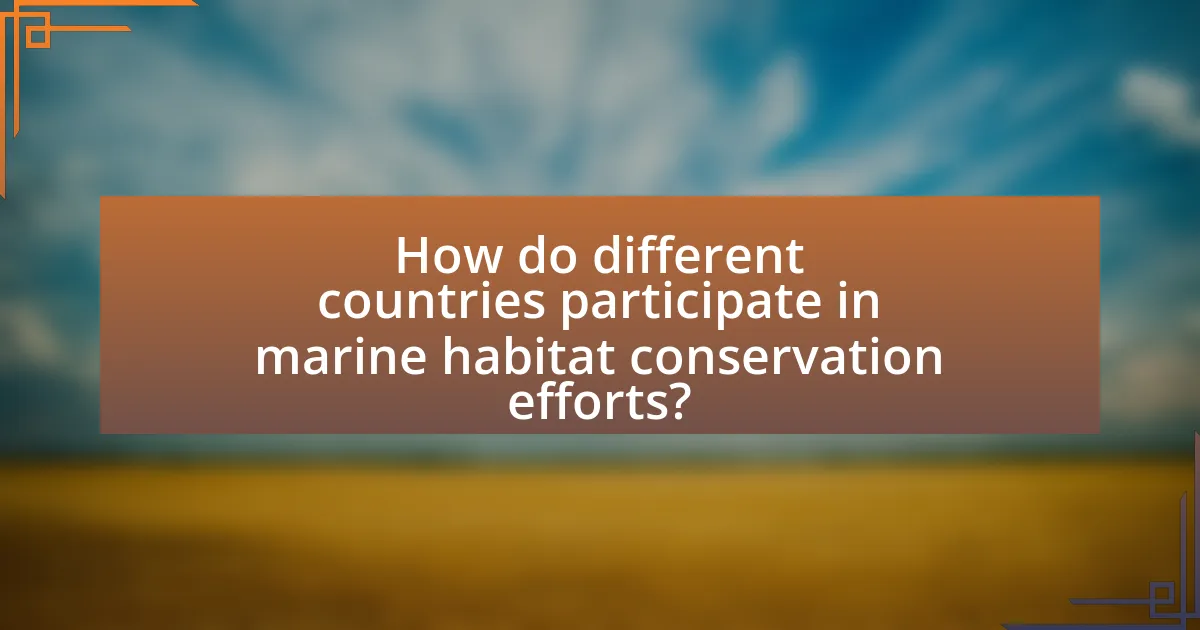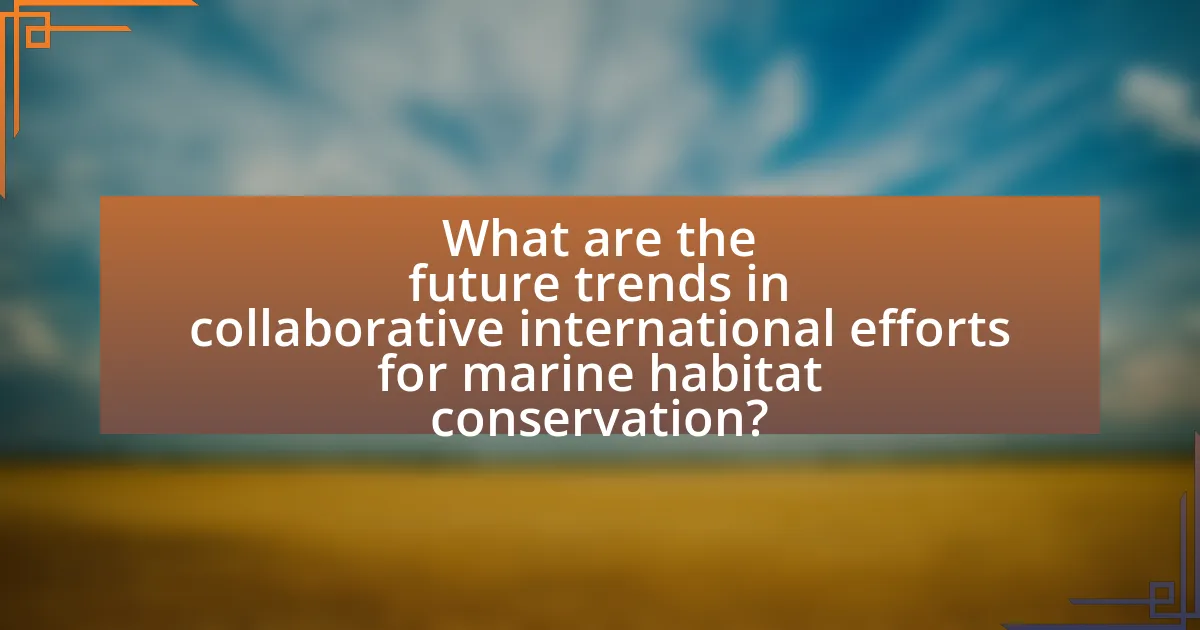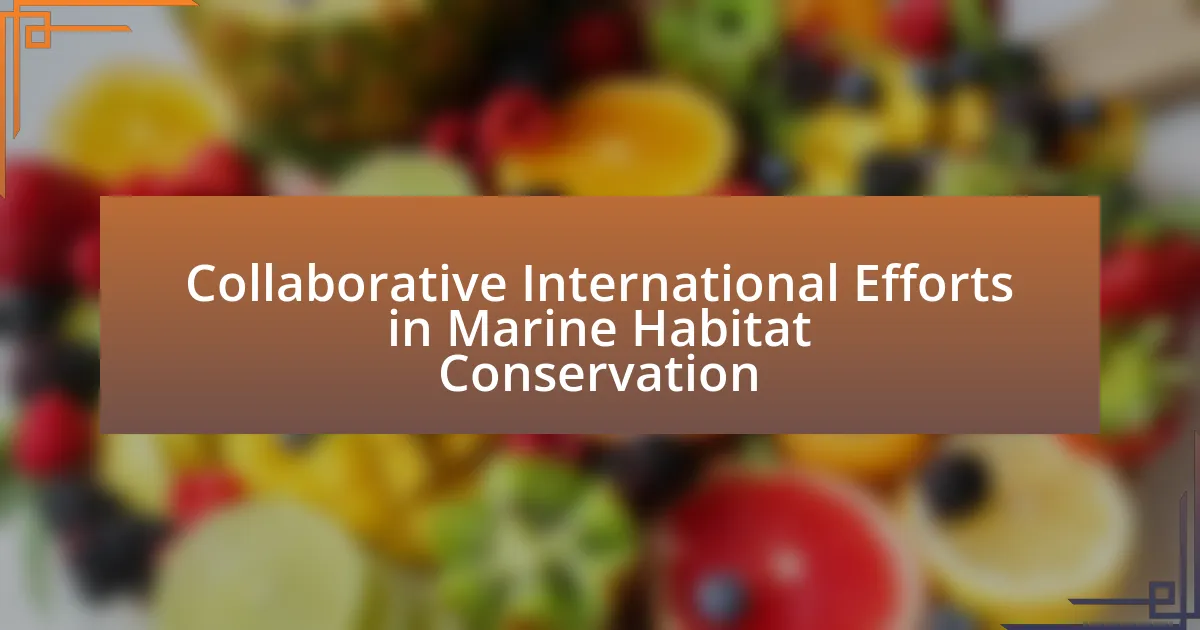Collaborative international efforts in marine habitat conservation involve multiple countries and organizations working together to protect and restore marine ecosystems. Key initiatives include the Convention on Biological Diversity and the United Nations Sustainable Development Goals, particularly Goal 14, which focuses on life below water. The article outlines the importance of marine habitat conservation for biodiversity, ecosystem services, and climate change mitigation, while also addressing threats such as climate change, overfishing, and pollution. It highlights successful collaborative projects, the roles of various countries and organizations, and the significance of involving local communities in conservation efforts. Additionally, it discusses future trends, the impact of technology, and best practices for enhancing international collaboration in marine conservation.

What are Collaborative International Efforts in Marine Habitat Conservation?
Collaborative international efforts in marine habitat conservation involve multiple countries and organizations working together to protect and restore marine ecosystems. These initiatives include agreements like the Convention on Biological Diversity, which aims to conserve marine biodiversity, and the United Nations Sustainable Development Goals, specifically Goal 14, which focuses on life below water. Collaborative efforts often result in the establishment of marine protected areas (MPAs) and joint research programs that share data and best practices, enhancing the effectiveness of conservation strategies. For example, the Coral Triangle Initiative, involving six countries, aims to safeguard the marine resources of the Coral Triangle, which is home to the highest diversity of coral reefs in the world.
Why is marine habitat conservation important on a global scale?
Marine habitat conservation is crucial on a global scale because it protects biodiversity, supports ecosystem services, and mitigates climate change. Healthy marine ecosystems, such as coral reefs and mangroves, provide habitat for countless species, with approximately 25% of marine life relying on coral reefs alone. Furthermore, these ecosystems contribute to carbon sequestration, with mangroves storing up to four times more carbon than terrestrial forests. The degradation of marine habitats can lead to significant losses in fish populations, which are vital for food security for over 3 billion people worldwide. Therefore, conserving marine habitats is essential for maintaining ecological balance, supporting livelihoods, and addressing global environmental challenges.
What are the key threats to marine habitats worldwide?
The key threats to marine habitats worldwide include climate change, overfishing, pollution, habitat destruction, and invasive species. Climate change leads to ocean warming and acidification, which adversely affect marine ecosystems; for instance, coral reefs are particularly vulnerable, with studies indicating that up to 90% of coral reefs could be lost by 2050 if current trends continue. Overfishing depletes fish populations and disrupts food webs, with the Food and Agriculture Organization reporting that 34% of global fish stocks are overfished. Pollution, including plastic waste and chemical runoff, contaminates marine environments, harming wildlife and ecosystems. Habitat destruction, often due to coastal development and bottom trawling, results in the loss of critical habitats such as mangroves and seagrasses. Lastly, invasive species can outcompete native species, leading to biodiversity loss, as evidenced by the introduction of lionfish in the Caribbean, which has devastated local fish populations.
How do marine habitats contribute to global biodiversity?
Marine habitats significantly contribute to global biodiversity by providing essential ecosystems that support a vast array of species. These habitats, including coral reefs, mangroves, and seagrasses, serve as critical breeding, feeding, and nursery grounds for numerous marine organisms. For instance, coral reefs alone are home to approximately 25% of all marine species, despite covering less than 1% of the ocean floor. This high level of species richness is vital for maintaining ecological balance and resilience. Furthermore, marine habitats facilitate nutrient cycling and carbon sequestration, which are crucial for sustaining life on Earth and mitigating climate change impacts.
What are the main objectives of international collaborations in marine conservation?
The main objectives of international collaborations in marine conservation are to enhance biodiversity protection, promote sustainable resource management, and address transboundary marine issues. These collaborations aim to create a unified approach to conserving marine ecosystems, as many marine species and habitats extend beyond national jurisdictions. For instance, the Convention on Biological Diversity emphasizes the need for cooperative strategies to protect marine biodiversity, highlighting that over 60% of the ocean lies outside national boundaries. Additionally, international partnerships facilitate the sharing of scientific research and best practices, which are crucial for effective conservation efforts.
How do these objectives align with global environmental goals?
The objectives of collaborative international efforts in marine habitat conservation align with global environmental goals by promoting biodiversity, sustainable resource management, and climate resilience. These efforts contribute to the United Nations Sustainable Development Goal 14, which aims to conserve and sustainably use the oceans, seas, and marine resources. For instance, initiatives like the Convention on Biological Diversity emphasize the protection of marine ecosystems, directly supporting global targets for reducing biodiversity loss. Additionally, the Paris Agreement highlights the importance of marine habitats in mitigating climate change impacts, reinforcing the need for international cooperation in conservation strategies.
What role do international treaties play in marine habitat conservation?
International treaties play a crucial role in marine habitat conservation by establishing legally binding commitments among nations to protect marine ecosystems. These treaties, such as the Convention on Biological Diversity and the United Nations Convention on the Law of the Sea, provide frameworks for cooperation, resource management, and the establishment of marine protected areas. For instance, the Convention on Biological Diversity aims to conserve biological diversity, promote sustainable use of its components, and ensure fair sharing of benefits arising from genetic resources, which directly supports marine habitat conservation efforts. Additionally, international treaties facilitate the sharing of scientific research and best practices, enhancing global strategies to combat threats like overfishing and pollution, thereby reinforcing the collective responsibility of nations to safeguard marine environments.
What are some examples of successful collaborative efforts in marine habitat conservation?
Successful collaborative efforts in marine habitat conservation include the Coral Triangle Initiative, which involves six countries working together to protect marine biodiversity in the Coral Triangle region, home to the highest diversity of coral species globally. Another example is the Partnership for the East African Coast, where multiple nations collaborate to manage and conserve coastal and marine resources, enhancing ecosystem resilience. Additionally, the Ocean Conservancy’s International Coastal Cleanup mobilizes volunteers worldwide to remove trash from coastlines, significantly improving marine habitats. These initiatives demonstrate effective collaboration across borders, leading to tangible conservation outcomes.
Which organizations are leading these collaborative initiatives?
The organizations leading collaborative initiatives in marine habitat conservation include the United Nations Environment Programme (UNEP), the World Wildlife Fund (WWF), and the International Union for Conservation of Nature (IUCN). UNEP plays a crucial role in coordinating global environmental efforts, while WWF focuses on conservation projects and advocacy. IUCN is instrumental in providing scientific research and policy guidance for sustainable marine practices. These organizations collaborate on various projects aimed at protecting marine ecosystems, demonstrating their commitment to international conservation efforts.
What specific projects have shown significant results?
The Coral Triangle Initiative (CTI) has shown significant results in marine habitat conservation. This collaborative effort among six countries—Indonesia, Malaysia, Papua New Guinea, the Philippines, Solomon Islands, and Timor-Leste—aims to protect the biodiversity of the Coral Triangle, which is home to over 75% of the world’s coral species. The CTI has successfully established marine protected areas (MPAs) that cover over 3 million square kilometers, leading to increased fish populations and improved local fisheries. Additionally, the project has enhanced community engagement and sustainable practices, demonstrating measurable improvements in both ecological health and local livelihoods.

How do different countries participate in marine habitat conservation efforts?
Different countries participate in marine habitat conservation efforts through international agreements, national policies, and collaborative projects. For instance, the Convention on Biological Diversity (CBD) encourages nations to develop marine protected areas (MPAs) to safeguard biodiversity, with over 190 countries committing to this initiative. Additionally, countries like Australia and the United States have established extensive networks of MPAs, contributing to global conservation goals. Collaborative efforts, such as the Coral Triangle Initiative involving six Southeast Asian nations, focus on preserving marine ecosystems through shared resources and strategies. These actions demonstrate a unified approach to addressing marine habitat degradation and promoting sustainable practices.
What are the roles of developed versus developing countries in these efforts?
Developed countries primarily provide financial resources, technology, and expertise for marine habitat conservation efforts, while developing countries often focus on implementing conservation strategies and managing local resources. Developed nations contribute approximately 90% of global funding for marine conservation initiatives, enabling projects that developing countries may lack the financial capacity to undertake. In contrast, developing countries leverage their local knowledge and biodiversity to implement these initiatives effectively, often collaborating with international organizations to enhance their conservation efforts. This division of roles facilitates a comprehensive approach to marine habitat conservation, addressing both funding and on-the-ground implementation challenges.
How do economic factors influence participation in marine conservation?
Economic factors significantly influence participation in marine conservation by determining the availability of resources and incentives for stakeholders. For instance, communities with limited financial resources may struggle to engage in conservation efforts due to the costs associated with sustainable practices, such as eco-friendly fishing methods or habitat restoration projects. Conversely, regions that offer economic incentives, such as grants or revenue from eco-tourism, tend to see higher participation rates in marine conservation initiatives. A study by the World Bank in 2020 highlighted that countries investing in marine protected areas experienced a 30% increase in local community involvement, demonstrating a direct correlation between economic support and conservation participation.
What challenges do developing countries face in marine habitat conservation?
Developing countries face significant challenges in marine habitat conservation, primarily due to limited financial resources, inadequate governance, and lack of technical expertise. Financial constraints hinder the ability to implement effective conservation programs, as many developing nations allocate a substantial portion of their budgets to immediate economic needs rather than long-term environmental sustainability. Inadequate governance often results in weak enforcement of environmental regulations, leading to overfishing, habitat destruction, and pollution. Furthermore, the lack of technical expertise limits the capacity to develop and implement scientifically informed conservation strategies. According to the United Nations Environment Programme, over 80% of marine pollution originates from land-based activities, which are exacerbated by the insufficient regulatory frameworks in many developing countries.
How do cultural and social factors impact international collaboration?
Cultural and social factors significantly impact international collaboration by influencing communication styles, trust-building, and decision-making processes among diverse stakeholders. For instance, varying cultural norms can affect how teams approach conflict resolution; in some cultures, direct confrontation is acceptable, while in others, indirect methods are preferred. This divergence can lead to misunderstandings and hinder effective collaboration. Additionally, social factors such as shared values and historical relationships between countries can either facilitate or obstruct partnerships. Research indicates that successful international collaborations often rely on establishing mutual respect and understanding, which are rooted in cultural awareness and social dynamics. For example, the United Nations Environment Programme emphasizes the importance of cultural sensitivity in fostering cooperation for marine conservation initiatives, highlighting that recognizing local customs and social structures can enhance stakeholder engagement and project outcomes.
What are the benefits of involving local communities in conservation efforts?
Involving local communities in conservation efforts enhances the effectiveness and sustainability of these initiatives. Local communities possess valuable traditional knowledge about their ecosystems, which can inform conservation strategies and improve outcomes. For instance, studies have shown that when local stakeholders are engaged, there is a higher likelihood of compliance with conservation regulations, as they feel a sense of ownership and responsibility towards their environment. Additionally, involving communities can lead to better resource management, as they often rely on these resources for their livelihoods, thus aligning conservation goals with local economic interests. Research indicates that community-led conservation projects can result in increased biodiversity and improved ecosystem health, demonstrating the tangible benefits of local involvement in conservation efforts.
How can cultural differences affect the success of collaborative projects?
Cultural differences can significantly affect the success of collaborative projects by influencing communication styles, decision-making processes, and conflict resolution strategies. For instance, in collaborative international efforts in marine habitat conservation, varying cultural norms can lead to misunderstandings or misinterpretations of intentions and objectives. Research by Hofstede (1980) highlights that cultures with high power distance may expect hierarchical decision-making, while those with low power distance may favor egalitarian approaches. This divergence can create friction in teams, impacting project timelines and outcomes. Additionally, a study published in the Journal of International Business Studies found that teams with diverse cultural backgrounds often experience challenges in establishing common goals, which can hinder collaboration and reduce overall effectiveness.

What are the future trends in collaborative international efforts for marine habitat conservation?
Future trends in collaborative international efforts for marine habitat conservation include increased integration of technology, enhanced policy frameworks, and greater stakeholder engagement. The use of advanced technologies such as satellite monitoring and artificial intelligence is expected to improve data collection and analysis, facilitating more effective conservation strategies. Additionally, international agreements like the Convention on Biological Diversity are evolving to incorporate stronger commitments to marine protection, aiming for at least 30% of the world’s oceans to be protected by 2030. Furthermore, the involvement of local communities and indigenous knowledge is gaining recognition, leading to more inclusive decision-making processes that enhance the effectiveness of conservation efforts. These trends are supported by the growing body of research highlighting the importance of collaborative approaches in addressing complex marine conservation challenges.
How is technology shaping marine conservation initiatives?
Technology is significantly shaping marine conservation initiatives by enhancing data collection, monitoring, and management practices. For instance, satellite imagery and remote sensing technologies allow researchers to track changes in marine ecosystems, such as coral bleaching events, with high precision. Additionally, underwater drones and autonomous vehicles facilitate the exploration and mapping of ocean habitats, providing critical information for conservation strategies. According to a study published in the journal “Frontiers in Marine Science,” the use of these technologies has improved the effectiveness of marine protected areas by enabling real-time monitoring of biodiversity and human activities. This integration of technology into marine conservation efforts leads to more informed decision-making and collaborative international initiatives aimed at preserving marine biodiversity.
What innovative tools are being used to monitor marine habitats?
Innovative tools used to monitor marine habitats include autonomous underwater vehicles (AUVs), remote sensing technologies, and environmental DNA (eDNA) analysis. AUVs, equipped with sensors, collect data on water quality, temperature, and biodiversity, enabling detailed mapping of marine ecosystems. Remote sensing technologies, such as satellite imagery and aerial drones, provide large-scale monitoring of habitat changes and health, allowing for real-time data collection over vast areas. eDNA analysis detects genetic material from organisms in water samples, offering insights into species presence and diversity without the need for physical capture. These tools enhance the understanding of marine environments and support conservation efforts by providing accurate, timely data.
How can data sharing enhance collaborative efforts?
Data sharing enhances collaborative efforts by facilitating access to critical information among stakeholders, which leads to informed decision-making and coordinated actions. In the context of marine habitat conservation, sharing data on species distribution, habitat conditions, and environmental threats allows researchers, policymakers, and conservationists to align their strategies effectively. For instance, a study published in the journal “Marine Policy” highlights that collaborative data-sharing initiatives among countries have resulted in improved management of shared marine resources, demonstrating that transparency and accessibility of data can significantly enhance collective conservation outcomes.
What best practices can enhance the effectiveness of international collaborations?
Establishing clear communication channels enhances the effectiveness of international collaborations. Effective communication ensures that all parties understand objectives, roles, and responsibilities, which is crucial in complex projects like marine habitat conservation. For instance, the Global Environment Facility emphasizes the importance of regular updates and feedback loops among stakeholders to maintain alignment and address challenges promptly. Additionally, fostering mutual respect and cultural sensitivity among diverse teams promotes collaboration, as highlighted in the United Nations Environment Programme’s guidelines for international partnerships. These practices lead to improved trust and cooperation, ultimately resulting in more successful conservation outcomes.
How can stakeholders ensure sustainable practices in marine conservation?
Stakeholders can ensure sustainable practices in marine conservation by implementing collaborative management strategies that involve local communities, governments, and scientific organizations. These strategies include establishing marine protected areas (MPAs), which have been shown to enhance biodiversity and fish populations; for example, a study published in the journal “Nature” found that MPAs can increase fish biomass by up to 600% over time. Additionally, stakeholders can promote sustainable fishing practices through regulations and community engagement, which have been effective in reducing overfishing and habitat destruction. By fostering partnerships and sharing knowledge, stakeholders can create a more resilient marine ecosystem that supports both conservation goals and local livelihoods.
What strategies can be employed to improve communication among international partners?
To improve communication among international partners in marine habitat conservation, employing strategies such as establishing clear communication protocols, utilizing technology for real-time collaboration, and fostering cultural awareness is essential. Clear communication protocols ensure that all partners understand their roles and responsibilities, which minimizes misunderstandings. Utilizing technology, such as video conferencing and collaborative platforms, facilitates real-time discussions and document sharing, enhancing engagement and responsiveness. Fostering cultural awareness helps partners navigate language barriers and differing communication styles, promoting mutual respect and understanding. These strategies are supported by studies indicating that effective communication significantly enhances collaborative outcomes in international conservation efforts.
What practical steps can individuals take to support marine habitat conservation?
Individuals can support marine habitat conservation by reducing plastic use, participating in local clean-up efforts, and advocating for sustainable seafood choices. Reducing plastic use minimizes ocean pollution, as an estimated 8 million tons of plastic enter the oceans annually, harming marine life. Participating in clean-up efforts directly removes debris from marine environments, contributing to healthier ecosystems. Advocating for sustainable seafood helps protect overfished species and supports responsible fishing practices, which are crucial for maintaining biodiversity in marine habitats.
